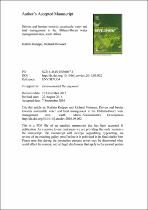 ResearchSpace
ResearchSpace
Drivers and barriers towards sustainable water and land management in the Olifants-Doorn Water Management Area, South Africa
JavaScript is disabled for your browser. Some features of this site may not work without it.
- ResearchSpace
- →
- Research Publications/Outputs
- →
- Journal Articles
- →
- View Item
| dc.contributor.author |
Knüppe, K

|
|
| dc.contributor.author |
Meissner, Richard

|
|
| dc.date.accessioned | 2018-03-14T12:58:12Z | |
| dc.date.available | 2018-03-14T12:58:12Z | |
| dc.date.issued | 2016-11 | |
| dc.identifier.citation | Knüppe, K. and Meissner, R. 2016. Drivers and barriers towards sustainable water and land management in the Olifants-Doorn Water Management Area, South Africa. Environmental Development, vol. 20: 3-14 | en_US |
| dc.identifier.issn | 2211-4645 | |
| dc.identifier.uri | https://www.sciencedirect.com/science/article/pii/S2211464515300671 | |
| dc.identifier.uri | https://doi.org/10.1016/j.envdev.2016.09.002 | |
| dc.identifier.uri | http://hdl.handle.net/10204/10104 | |
| dc.description | Copyright: 2016 Elsevier. Due to copyright restrictions, the attached PDF file only contains the accepted version of the published article. For access to the published item, please consult the publisher's website. | en_US |
| dc.description.abstract | Over the last 17 years South Africa's water and land resources management has changed dramatically. This rapid evolution has been accompanied by a growing number of laws and policies to co-balance water allocation for human basic needs and ecosystem integrity. Most often, new ideas and innovative concepts constitute new challenges towards their implementation. This paper examines drivers and barriers towards more sustainable and integrated governance and management practices from the perspective of ecosystem services in the Olifants-Doorn Water Management Area (WMA). Results obtained from a literature search and qualitative interviews indicate that the environmental awareness of stakeholders about their natural resources and related ecosystem services increased over the last years. Furthermore, we observed that the establishment of new polices became a key driver towards increased sustainability within the Olifants-Doorn WMA. Nonetheless, ensuring coherence between sectors and actors when considering natural resource governance remains a major challenge. For future sustainable developments, decentralized and localized management structures as well as the establishment of strong leadership should be emphasized in the Olifants-Doorn WMA. Further, sufficient water and land monitoring systems are necessary for decision makers, farmers and local water suppliers in order to maintain ecosystem services and their values for human well-being. | en_US |
| dc.language.iso | en | en_US |
| dc.publisher | Elsevier | en_US |
| dc.relation.ispartofseries | Worklist;20480 | |
| dc.subject | Ecosystem services | en_US |
| dc.subject | Water governance and management | en_US |
| dc.subject | South Africa | en_US |
| dc.subject | Olifants-Doorn Water Management Area | en_US |
| dc.title | Drivers and barriers towards sustainable water and land management in the Olifants-Doorn Water Management Area, South Africa | en_US |
| dc.type | Article | en_US |
| dc.identifier.apacitation | Knüppe, K., & Meissner, R. (2016). Drivers and barriers towards sustainable water and land management in the Olifants-Doorn Water Management Area, South Africa. http://hdl.handle.net/10204/10104 | en_ZA |
| dc.identifier.chicagocitation | Knüppe, K, and Richard Meissner "Drivers and barriers towards sustainable water and land management in the Olifants-Doorn Water Management Area, South Africa." (2016) http://hdl.handle.net/10204/10104 | en_ZA |
| dc.identifier.vancouvercitation | Knüppe K, Meissner R. Drivers and barriers towards sustainable water and land management in the Olifants-Doorn Water Management Area, South Africa. 2016; http://hdl.handle.net/10204/10104. | en_ZA |
| dc.identifier.ris | TY - Article AU - Knüppe, K AU - Meissner, Richard AB - Over the last 17 years South Africa's water and land resources management has changed dramatically. This rapid evolution has been accompanied by a growing number of laws and policies to co-balance water allocation for human basic needs and ecosystem integrity. Most often, new ideas and innovative concepts constitute new challenges towards their implementation. This paper examines drivers and barriers towards more sustainable and integrated governance and management practices from the perspective of ecosystem services in the Olifants-Doorn Water Management Area (WMA). Results obtained from a literature search and qualitative interviews indicate that the environmental awareness of stakeholders about their natural resources and related ecosystem services increased over the last years. Furthermore, we observed that the establishment of new polices became a key driver towards increased sustainability within the Olifants-Doorn WMA. Nonetheless, ensuring coherence between sectors and actors when considering natural resource governance remains a major challenge. For future sustainable developments, decentralized and localized management structures as well as the establishment of strong leadership should be emphasized in the Olifants-Doorn WMA. Further, sufficient water and land monitoring systems are necessary for decision makers, farmers and local water suppliers in order to maintain ecosystem services and their values for human well-being. DA - 2016-11 DB - ResearchSpace DP - CSIR KW - Ecosystem services KW - Water governance and management KW - South Africa KW - Olifants-Doorn Water Management Area LK - https://researchspace.csir.co.za PY - 2016 SM - 2211-4645 T1 - Drivers and barriers towards sustainable water and land management in the Olifants-Doorn Water Management Area, South Africa TI - Drivers and barriers towards sustainable water and land management in the Olifants-Doorn Water Management Area, South Africa UR - http://hdl.handle.net/10204/10104 ER - | en_ZA |





